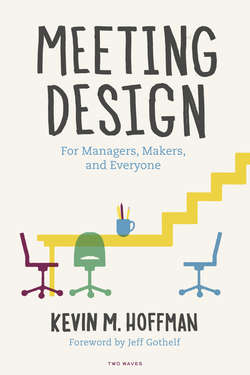Читать книгу Meeting Design - Kevin M. Hoffman - Страница 17
На сайте Литреса книга снята с продажи.
A Better Definition of “Meeting”
ОглавлениеHabits are the result of behaviors becoming separated from an awareness of the intentions behind those behaviors. When habits form as parts of the process of working together, such as standing meetings, those meetings start to be labeled with descriptions, rather than ascribed with purpose. They are “where the team gathers,” or “when we talk about the project,” or simply “that thing we do on Tuesday.” When you apply a design process to meetings, you reconnect getting together with having a reason to do it.
Consider the very next meeting that you’re about to have. Do you have doubts about its value? Ask yourself, or your team, two simple questions about that meeting. These questions will help you define its job in a way that reconnects it to a larger purpose.
• What is the outcome this meeting will enable?
• How can you measure that outcome?
That’s a simpler, better definition for a meeting. A meeting is something that enables us to achieve an outcome that we can’t otherwise achieve without it, measured in an agreed-upon fashion. We don’t call a car “that thing with wheels and seats,” even though it’s as accurate of a definition as “that thing we do on Tuesday.” If you’ve got the money for gas and maintenance, a car is the freedom to relocate yourself. A meeting is a mechanism for creating meaningful change in your work.
WHAT YOU NEED TO KNOW
People will call new meetings or continue to have existing ones because they’re upset about a previous failure, or they fear a future one. As a result, meeting agendas get stuck in a very small part of the design process loop: considering and applying a single approach. That stagnation crowds calendars with standing meetings and leads them into standing boredom and standing confusion. To alleviate that stagnation, apply a design process to meetings with the following four steps.
1. Identify the problem that the meeting is intended to solve and research the problem before committing to a meeting.
2. Consider more than one approach to a meeting.
3. Make small changes to a meeting based on observed improvements or failures.
4. Know when the meeting has done its job and then walk away from it.
By asking these questions, you should be able to figure out when a standing meeting is a good idea and when it isn’t. Once you’re sure a meeting is going to do the trick, the next step is to take a hard look at what a meeting is composed of and start iterating and making those small changes.
We don’t reflect on our collaboration nearly enough. How could we have worked together better? How could we have gotten to this outcome sooner? What was a good use of our time? Where did it sort of drag on? We need to actually sit down and take it apart.
—JARED SPOOL MAKER OF AWESOMENESS, CENTER CENTRE AND UIE
In case it wasn’t obvious, this approach applies to any kind of meeting. It illustrates the differences between the problems a single meeting (or series of meetings) is intended to solve and the larger intentions of a project, or even an organization. It goes without saying that those intentions vary greatly based on the kind of work, the position within the organizational hierarchy, and the organizational culture. These are the constraints placed upon meetings, which are explored more extensively in the following chapters. However, before considering multiple approaches, you need to do step one, which is to understand the problem as bounded by its constraints. And there’s one constraint that all meetings share, which you’ll learn about in the next chapter.
